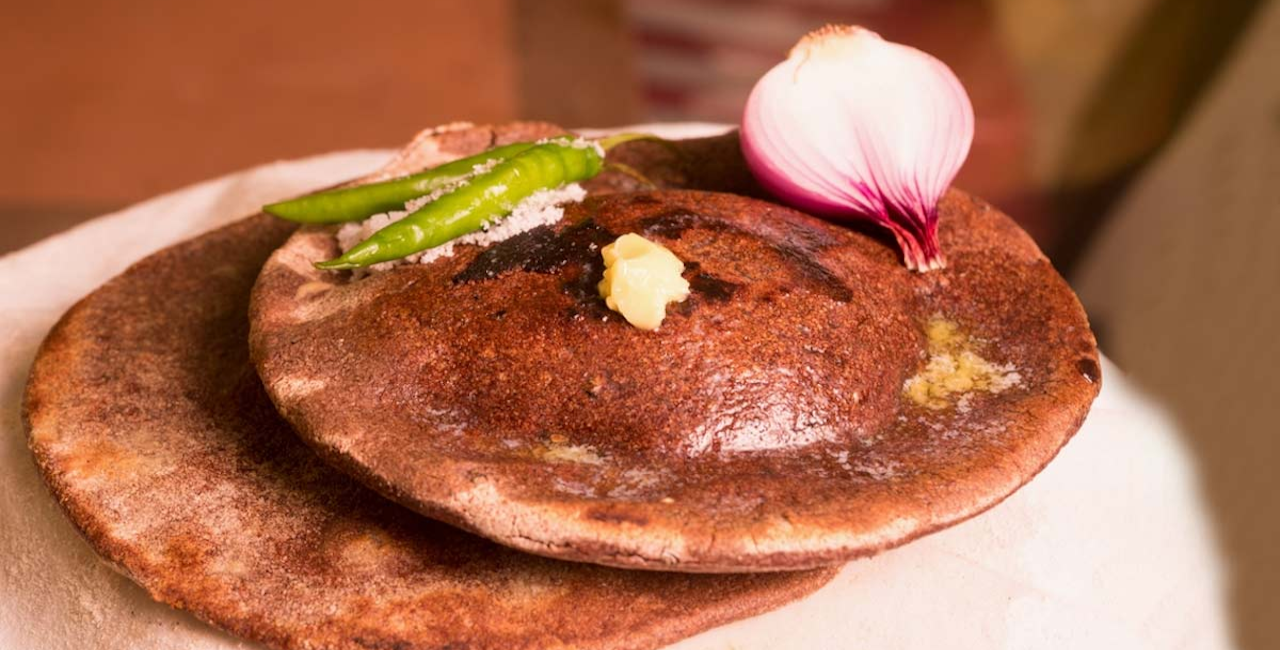Currently Empty: ₹0.00

Mandua ki Roti, also known as Roti made from finger millet flour (mandua or ragi), is a traditional Indian flatbread cherished for its rich nutritional profile and unique flavor. This wholesome bread has its roots in the Indian states of Uttarakhand and Himachal Pradesh, where it has been a staple food for centuries. Known for its earthy taste and dense texture, Mandua ki Roti is an integral part of the local cuisine and reflects the agricultural practices of the region, where finger millet is cultivated in the terraced fields.
Nutritional Benefits of Mandua (Ragi)
Mandua, or ragi, is considered one of the most nutritious grains available. It is a rich source of dietary fiber, making it beneficial for digestive health. It is also packed with essential amino acids, vitamins, and minerals, including calcium, iron, and magnesium. This makes Mandua ki Roti an excellent choice for people looking to improve their overall health, manage weight, or combat conditions such as anemia.
Moreover, finger millet is gluten-free, making it a suitable option for those with gluten intolerance or celiac disease. Its low glycemic index helps in regulating blood sugar levels, making it a smart choice for individuals with diabetes. The presence of antioxidants in ragi also promotes overall health and may help in reducing the risk of chronic diseases.
Traditional Preparation of Mandua ki Roti
The preparation of Mandua ki Roti is a simple yet rewarding process that involves just a few key ingredients: mandua flour, water, and a pinch of salt. The traditional method begins with the kneading of the flour with water to form a soft, pliable dough. This dough may also incorporate ingredients such as chopped greens, spices, or herbs, enhancing the flavor and nutritional value.
Once the dough is ready, small balls are shaped and rolled out into flat, round discs using a rolling pin. Due to the lack of gluten in mandua flour, the rolling process can be slightly challenging, as the dough is more brittle compared to wheat flour. To avoid cracking, it’s common to use a little dry flour while rolling.
The rolled-out roti is then cooked on a hot tava (griddle) until both sides develop a nice brown color and puff up slightly. Traditionally, some people prefer to roast the rotis directly over an open flame after cooking on the tava to give them a smoky flavor. This step enhances the aroma and taste, making Mandua ki Roti a delightful accompaniment to various dishes.
Serving Suggestions
Mandua ki Roti is versatile and can be paired with an array of accompaniments. In Uttarakhand, it is often enjoyed with gahat (horse gram) curry, a rich, protein-packed dish that complements the earthy flavors of the roti. It can also be served with other vegetable curries, lentils, or yogurt for a wholesome meal.
Additionally, Mandua ki Roti can be enjoyed with homemade pickles, chutneys, or a drizzle of ghee or butter for added richness. The unique flavor of the roti makes it a great option for both traditional meals and contemporary cuisine.
Cultural Significance
Mandua ki Roti holds cultural significance in the regions where it is consumed. It is often associated with rural life and traditional farming practices, where finger millet was cultivated as a staple crop due to its resilience in hilly terrains and harsh climatic conditions. In many households, the preparation and consumption of Mandua ki Roti symbolize a connection to heritage and agricultural roots.
In festivals and special occasions, Mandua ki Roti may be prepared alongside other traditional dishes, reflecting the culinary diversity of the region. Its consumption during the winter months is particularly popular, as it is believed to provide warmth and energy, making it a go-to comfort food during colder days.
Modern Adaptations
As health consciousness grows, Mandua ki Roti is gaining popularity beyond its traditional roots. People are increasingly recognizing the nutritional benefits of ragi, leading to its incorporation into various recipes. In contemporary cooking, it can be used to prepare fusion dishes like wraps, pizzas, or even snacks like cutlets and dosa, catering to a wider audience.
Health enthusiasts and nutritionists advocate for the inclusion of Mandua in daily diets, encouraging people to explore its versatility in meals. With the rise of organic farming and awareness about millets, Mandua is being promoted as a sustainable and healthy food choice in urban centers as well.
Conclusion
Mandua ki Roti is more than just a flatbread; it is a reflection of the rich cultural heritage and nutritional wisdom of Indian cuisine. With its earthy flavor, health benefits, and adaptability, it continues to find a place in the hearts and kitchens of people across the country. Whether enjoyed in a traditional setting or reinvented in modern recipes, Mandua ki Roti serves as a reminder of the importance of wholesome, locally sourced foods in our diets. For those seeking to experience authentic Indian flavors and embrace healthy eating, Mandua ki Roti is a delicious and nutritious choice that stands the test of time.


